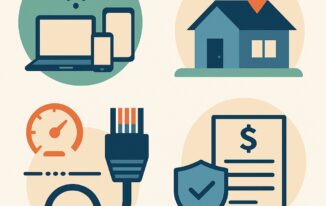
Many families today need a reliable and fast internet connection for entertainment, work, communication, and online businesses. However, people who have moved houses or are planning to switch internet service providers (ISPs) should learn how to find the best provider in their area.
If a client chooses an unreliable ISP, switching to another might lead to penalties, inconveniences, and additional expenses. This article will highlight tips for finding the best home internet provider.
Define Internet Needs
Internet connections can be used for many applications at home. Clients should seek to understand their needs before reviewing the types of internet service. For instance, light browsers who only need to check emails or search for the latest news may not need to pay for a high-speed internet connection. However, heavy internet users who use many devices for online work, trading, streaming, or gaming need a high bandwidth connection.
The intended use also determines the ideal internet speed. For instance, 4K streaming might need a speed of at least 25 Mbps, while regular HD streaming only needs about 5 Mbps. Another consideration is the number of devices that use the internet simultaneously. Homes with many devices for school work, gaming, video conferencing, and streaming require a connection with low latency and high speed.
Identify the Available ISPs
People looking for internet services should identify all the providers in their area. They can start by searching online and through social media before asking neighbors. Potential clients can easily get insights into the best local ISPs from their neighbors and friends, review websites, and social media.
They should pay attention to comments about the internet speed, reliability, customer support, and internet charges. The client should then visit the ISP websites to check the terms, packages available, subscription amount, and any offers or discounts.
Compare Internet Types
Fiber internet is probably the most popular because it is reliable and fast. It is ideal for heavy users with many devices, but generally costs more. Cable internet is available in most areas. It is slower than a fiber internet connection and usually becomes slower during peak hours. DSL internet connections are slower than fiber and cable connections, making them ideal for light browsing in rural areas.
Satellite internet is another option that can work in urban centers and remote locations. People in rural areas can also consider a fixed wireless connection, which relies on radio signals. Some clients can also find 5G home internet, which is quite reliable but limited to a few locations. Clients should ask about the connection type and how it might affect their work.
Compare Speeds and Subscription Plans
After identifying ISPs and their connection types, potential clients should compare internet speeds with their subscription plans. Some packages might seem affordable but have daily, weekly, or monthly data caps, beyond which the connection slows down. Clients should ask about service bundles such as internet, TV, and phone service under one package.
Many ISPs have attractive discounts for new customers, which clients should look out for. However, they should read and understand the contract and ask about installation fees, internet equipment costs, penalties, and hidden charges. Clients should also test the connection and take advantage of the trial period or money-back guarantee if necessary.
Internet users looking to change their service provider should follow these tips to find a reliable one. If they overlook these factors, they might not get value for their money due to slow connection, unreliability, or poor connections. With a reliable ISP, clients enjoy a stable connection without spending too much money.



